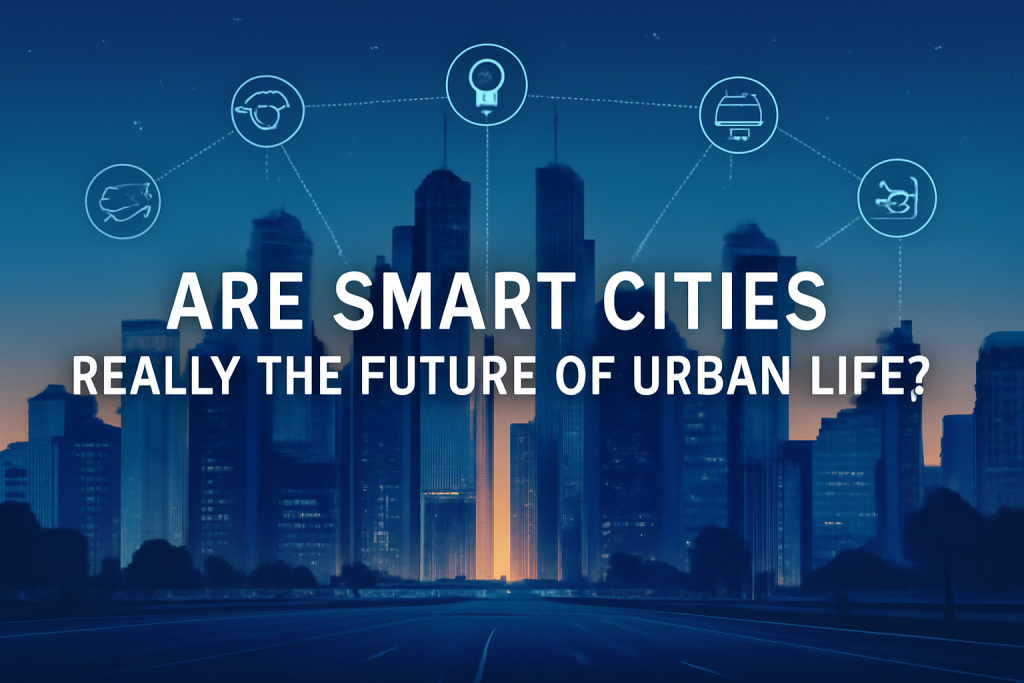In recent years, the concept of smart cities has gained significant attention as urban populations grow and technology advances. Smart cities are designed to use data, sensors, and connected technology to improve the quality of life, enhance sustainability, and optimize urban services. But the question remains: are smart cities really the future of urban life? This article examines the current trends, benefits, challenges, and emerging developments shaping smart cities, helping readers understand whether this concept is poised to define the next era of urban living.

What Is a Smart City?
A smart city integrates information and communication technologies (ICT) with physical infrastructure to manage resources efficiently and provide better services to its residents. It uses interconnected devices—part of the Internet of Things (IoT)—to collect real-time data on everything from traffic flow to energy consumption. The goal is to use this data to optimize urban systems such as transportation, energy grids, waste management, and public safety.
Smart city features often include:
- Smart transportation: Real-time traffic monitoring, adaptive traffic signals, and integrated public transit systems.
- Energy efficiency: Smart grids and renewable energy integration.
- Waste management: Sensor-enabled trash bins and optimized collection routes.
- Public safety: Surveillance systems combined with AI for crime detection.
- Environmental monitoring: Air quality and noise level tracking.
Why Are Smart Cities Gaining Momentum?
Several factors contribute to the growing interest in smart cities:
- Rapid Urbanization: According to the United Nations, 68% of the world population is projected to live in urban areas by 2050. Managing this growth demands innovative solutions to reduce congestion, pollution, and resource waste.
- Technological Advances: The expansion of 5G networks, IoT devices, big data analytics, and AI enables smarter, faster decision-making and better urban management.
- Sustainability Goals: Cities contribute over 70% of global CO2 emissions. Smart cities can help reduce environmental footprints by optimizing energy use and promoting green infrastructure.
- Improving Quality of Life: By enhancing public services, reducing commute times, and increasing safety, smart cities aim to make urban living more convenient and healthier.
Emerging Trends in Smart Cities
Several trends reveal how smart cities are evolving today:
1. Focus on Citizen Engagement
Smart cities increasingly prioritize citizen participation in decision-making through digital platforms. Apps and online portals allow residents to report issues, access services, and provide feedback. This two-way communication can foster transparency and trust.
2. Integration of AI and Machine Learning
Artificial intelligence is powering predictive analytics in traffic management, energy demand forecasting, and emergency response. For example, AI algorithms can predict traffic congestion and adjust traffic lights to improve flow.
3. Expansion of Mobility-as-a-Service (MaaS)
MaaS platforms combine multiple transport options—buses, bikes, ride-sharing—into one service accessible via smartphone. This helps reduce private car use and encourages more sustainable transport habits.
4. Emphasis on Data Privacy and Security
With extensive data collection, protecting citizens’ privacy and securing infrastructure is a growing concern. Regulations such as GDPR in Europe guide smart city projects to implement strong data governance.
Benefits of Smart Cities
The adoption of smart city technologies offers multiple advantages:
- Efficiency: Real-time data enables quicker responses and reduces operational costs.
- Environmental Impact: Optimized energy use and waste management reduce pollution.
- Economic Growth: Improved infrastructure attracts businesses and supports innovation.
- Safety: Advanced monitoring enhances emergency services and crime prevention.
- Accessibility: Smart services can improve access for differently-abled residents.
Challenges Facing Smart Cities
Despite the promise, smart cities face significant hurdles:
1. High Implementation Costs
Developing the necessary infrastructure, sensors, and platforms requires large investments. Many cities struggle to fund these projects or justify expenses against immediate needs.
2. Technological Fragmentation
Smart city components often come from multiple vendors with incompatible standards, complicating integration and data sharing.
3. Digital Divide
Not all residents have equal access to digital tools, risking increased inequality if services primarily benefit connected users.
4. Data Privacy Concerns
Extensive surveillance and data collection can lead to misuse or unauthorized access to sensitive information, raising ethical issues.
5. Governance Complexity
Smart city projects demand coordination across different government departments, private companies, and the public, which can slow progress.
Are Smart Cities Really the Future of Urban Life?
The evidence suggests that smart cities are likely to play a significant role in shaping urban life but may not be the sole future model for all cities. The success of smart city initiatives depends on:
- Tailored Solutions: Cities vary widely in size, culture, and resources. Smart technologies must be adapted to local needs and capacities.
- Public Trust: Ensuring transparency and protecting data privacy are critical to gaining citizen support.
- Sustainability Focus: Technologies must genuinely reduce environmental impact rather than simply digitalize existing inefficient systems.
- Inclusive Access: Bridging the digital divide is essential to avoid excluding vulnerable populations.
Several cities around the world are already implementing smart city concepts with promising results. For example, Singapore’s Smart Nation initiative integrates sensors and AI across government services and infrastructure. Barcelona has successfully used smart water and waste management systems, improving resource efficiency.
However, experts caution that technology alone will not solve urban challenges. Social policies, affordable housing, and community development remain crucial components of future urban life.
Practical Steps for Cities Moving Toward Smart Solutions
If your city or community is interested in embracing smart city principles, consider these practical steps:
- Start Small and Scale: Pilot projects in specific areas like smart lighting or traffic management can demonstrate value before wider rollout.
- Engage Stakeholders: Collaborate with residents, businesses, technology providers, and government agencies to ensure aligned goals.
- Prioritize Data Governance: Develop clear policies on data collection, usage, and privacy to build trust.
- Invest in Infrastructure: Reliable connectivity and power supply are foundational to smart technologies.
- Ensure Accessibility: Design services and apps that are user-friendly and accessible to all demographic groups.
Conclusion
Are smart cities really the future of urban life? The answer lies in a nuanced “yes.” While smart city technologies offer tools to make urban areas more efficient, sustainable, and livable, their impact depends on thoughtful implementation, citizen involvement, and equitable access. The next decades will likely see increasing integration of smart technologies in cities worldwide, but success will come from combining technology with strong governance and social policies.
By understanding the opportunities and challenges, cities can better prepare for a future where urban life is shaped by intelligent systems—yet remains centered on the people who live there.
References
- United Nations, World Urbanization Prospects, 2018. https://population.un.org/wup/
- McKinsey & Company, Smart Cities: Digital Solutions for a More Livable Future, 2023. https://www.mckinsey.com/industries/capital-projects-and-infrastructure/our-insights/smart-cities-digital-solutions-for-a-more-livable-future
- World Economic Forum, Why smart cities must put citizens at the heart of urban transformation, 2021. https://www.weforum.org/agenda/2021/09/smart-cities-citizens-urban-transformation/






